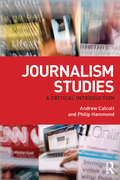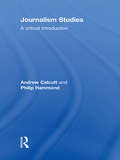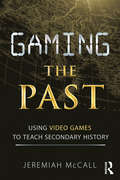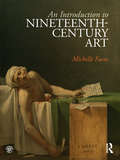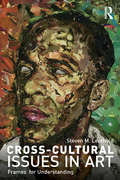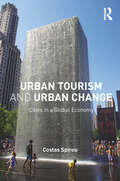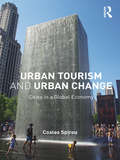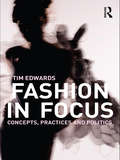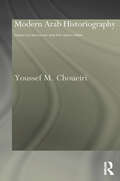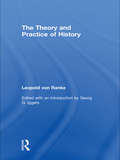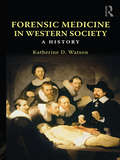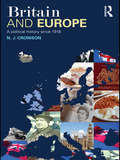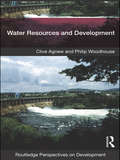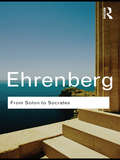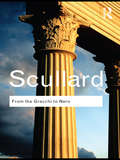- Table View
- List View
Journalism Studies: A Critical Introduction
by Andrew Calcutt Philip HammondAs the world of politics and public affairs has gradually changed beyond recognition over the past two decades, journalism too has been transformed... yet the study of news and journalism often seems stuck with ideas and debates which have lost much of their critical purchase. Journalism is at a crossroads: it needs to reaffirm core values and rediscover key activities, almost certainly in new forms, or it risks losing its distinctive character as well as its commercial basis. Journalism Studies is a polemical textbook that rethinks the field of journalism studies for the contemporary era. Organised around three central themes – ownership, objectivity and the public – Journalism Studies addresses the contexts in which journalism is produced, practised and disseminated. It outlines key issues and debates, reviewing established lines of critique in relation to the state of contemporary journalism, then offering alternative ways of approaching these issues, seeking to reconceptualise them in order to suggest an agenda for change and development in both journalism studies and journalism itself. Journalism Studies is a concise and accessible introduction to contemporary journalism studies, and will be highly useful to undergraduate and postgraduate students on a range of Journalism, Media and Communications courses.
Journalism Studies: A Critical Introduction
by Andrew Calcutt Philip HammondAs the world of politics and public affairs has gradually changed beyond recognition over the past two decades, journalism too has been transformed... yet the study of news and journalism often seems stuck with ideas and debates which have lost much of their critical purchase. Journalism is at a crossroads: it needs to reaffirm core values and rediscover key activities, almost certainly in new forms, or it risks losing its distinctive character as well as its commercial basis. Journalism Studies is a polemical textbook that rethinks the field of journalism studies for the contemporary era. Organised around three central themes – ownership, objectivity and the public – Journalism Studies addresses the contexts in which journalism is produced, practised and disseminated. It outlines key issues and debates, reviewing established lines of critique in relation to the state of contemporary journalism, then offering alternative ways of approaching these issues, seeking to reconceptualise them in order to suggest an agenda for change and development in both journalism studies and journalism itself. Journalism Studies is a concise and accessible introduction to contemporary journalism studies, and will be highly useful to undergraduate and postgraduate students on a range of Journalism, Media and Communications courses.
Gaming the Past: Using Video Games to Teach Secondary History
by Jeremiah McCallDespite the growing number of books designed to radically reconsider the educational value of video games as powerful learning tools, there are very few practical guidelines conveniently available for prospective history and social studies teachers who actually want to use these teaching and learning tools in their classes. As the games and learning field continues to grow in importance, Gaming the Past provides social studies teachers and teacher educators help in implementing this unique and engaging new pedagogy. This book focuses on specific examples to help social studies educators effectively use computer simulation games to teach critical thinking and historical analysis. Chapters cover the core parts of conceiving, planning, designing, and implementing simulation based lessons. Additional topics covered include: Talking to colleagues, administrators, parents, and students about the theoretical and practical educational value of using historical simulation games. Selecting simulation games that are aligned to curricular goals Determining hardware and software requirements, purchasing software, and preparing a learning environment incorporating simulations Planning lessons and implementing instructional strategies Identifying and avoiding common pitfalls Developing activities and assessments for use with simulation games that facilitate the interpretation and creation of established and new media Also included are sample unit and lesson plans and worksheets as well as suggestions for further reading. The book ends with brief profiles of the majority of historical simulation games currently available from commercial vendors and freely on the Internet.
Gaming the Past: Using Video Games to Teach Secondary History
by Jeremiah McCallDespite the growing number of books designed to radically reconsider the educational value of video games as powerful learning tools, there are very few practical guidelines conveniently available for prospective history and social studies teachers who actually want to use these teaching and learning tools in their classes. As the games and learning field continues to grow in importance, Gaming the Past provides social studies teachers and teacher educators help in implementing this unique and engaging new pedagogy. This book focuses on specific examples to help social studies educators effectively use computer simulation games to teach critical thinking and historical analysis. Chapters cover the core parts of conceiving, planning, designing, and implementing simulation based lessons. Additional topics covered include: Talking to colleagues, administrators, parents, and students about the theoretical and practical educational value of using historical simulation games. Selecting simulation games that are aligned to curricular goals Determining hardware and software requirements, purchasing software, and preparing a learning environment incorporating simulations Planning lessons and implementing instructional strategies Identifying and avoiding common pitfalls Developing activities and assessments for use with simulation games that facilitate the interpretation and creation of established and new media Also included are sample unit and lesson plans and worksheets as well as suggestions for further reading. The book ends with brief profiles of the majority of historical simulation games currently available from commercial vendors and freely on the Internet.
An Introduction to Nineteenth-Century Art
by Michelle FacosUsing the tools of the "new" art history (feminism, Marxism, social context, etc.) An Introduction to Nineteenth-Century Art offers a richly textured, yet clear and logical, introduction to nineteenth-century art and culture. This textbook will provide readers with a basic historical framework of the period and the critical tools for interpreting and situating new and unfamiliar works of art. Michelle Facos goes beyond existing histories of nineteenth-century art, which often focus solely on France, Britain, and the United States, to incorporate artists and artworks from Scandinavia, Germany, and Eastern Europe. The book expertly balances its coverage of trends and individual artworks: where the salient trends are clear, trend-setting works are highlighted, and the complexity of the period is respected by situating all works in their proper social and historical context. In this way, the student reader achieves a more nuanced understanding of the way in which the story of nineteenth-century art is the story of the ways in which artists and society grappled with the problem of modernity. Key pedagogical features include: Data boxes provide statistics, timelines, charts, and historical information about the period to further situate artworks. Text boxes highlight extracts from original sources, citing the ideas of artists and their contemporaries, including historians, philosophers, critics, and theorists, to place artists and works in the broader context of aesthetic, cultural, intellectual, social, and political conditions in which artists were working. Beautifully illustrated with over 250 color images. Margin notes and glossary definitions. Online resources at www.routledge.com/textbooks/facos with access to a wealth of information, including original documents pertaining to artworks discussed in the textbook, contemporary criticism, timelines and maps to enrich your understanding of the period and allow for further comparison and exploration. Chapters take a thematic approach combined within an overarching chronology and more detailed discussions of individual works are always put in the context of the broader social picture, thus providing students with a sense of art history as a controversial and alive arena of study. Michelle Facos teaches art history at Indiana University, Bloomington. Her research explores the changing relationship between artists and society since the Enlightenment and issues of identity. Prior publications include Nationalism and the Nordic Imagination: Swedish Painting of the 1890s (1998), Art, Culture and National Identity in Fin-de-Siècle Europe, co-edited with Sharon Hirsh (2003), and Symbolist Art in Context (2009).
An Introduction to Nineteenth-Century Art
by Michelle FacosUsing the tools of the "new" art history (feminism, Marxism, social context, etc.) An Introduction to Nineteenth-Century Art offers a richly textured, yet clear and logical, introduction to nineteenth-century art and culture. This textbook will provide readers with a basic historical framework of the period and the critical tools for interpreting and situating new and unfamiliar works of art. Michelle Facos goes beyond existing histories of nineteenth-century art, which often focus solely on France, Britain, and the United States, to incorporate artists and artworks from Scandinavia, Germany, and Eastern Europe. The book expertly balances its coverage of trends and individual artworks: where the salient trends are clear, trend-setting works are highlighted, and the complexity of the period is respected by situating all works in their proper social and historical context. In this way, the student reader achieves a more nuanced understanding of the way in which the story of nineteenth-century art is the story of the ways in which artists and society grappled with the problem of modernity. Key pedagogical features include: Data boxes provide statistics, timelines, charts, and historical information about the period to further situate artworks. Text boxes highlight extracts from original sources, citing the ideas of artists and their contemporaries, including historians, philosophers, critics, and theorists, to place artists and works in the broader context of aesthetic, cultural, intellectual, social, and political conditions in which artists were working. Beautifully illustrated with over 250 color images. Margin notes and glossary definitions. Online resources at www.routledge.com/textbooks/facos with access to a wealth of information, including original documents pertaining to artworks discussed in the textbook, contemporary criticism, timelines and maps to enrich your understanding of the period and allow for further comparison and exploration. Chapters take a thematic approach combined within an overarching chronology and more detailed discussions of individual works are always put in the context of the broader social picture, thus providing students with a sense of art history as a controversial and alive arena of study. Michelle Facos teaches art history at Indiana University, Bloomington. Her research explores the changing relationship between artists and society since the Enlightenment and issues of identity. Prior publications include Nationalism and the Nordic Imagination: Swedish Painting of the 1890s (1998), Art, Culture and National Identity in Fin-de-Siècle Europe, co-edited with Sharon Hirsh (2003), and Symbolist Art in Context (2009).
Cross-Cultural Issues in Art: Frames for Understanding
by Steven LeutholdCross-Cultural Issues in Art provides an engaging introduction to aesthetic concepts, expanding the discussion beyond the usual Western theorists and Western examples. Steven Leuthold discusses both contemporary and historical issues and examples, incorporating a range of detailed case studies from African, Asian, European, Latin American, Middle Eastern and Native American art. Individual chapters address broad intercultural issues in art, including Art and Culture, Primitivism and Otherness, Colonialism, Nationalism, Art and Religion, Symbolism and Interpretation, Style and Ethnicity, A Sense of Place, Art and Social Order, Gender, and the Self, considering these themes as constructs that frame our understanding of art. Cross-Cultural Issues in Art draws upon ideas and case studies from cultural and critical studies, art history, ethno-aesthetics and area studies, visual anthropology, and philosophy, and will be useful for undergraduate and postgraduate courses in these fields.
Cross-Cultural Issues in Art: Frames for Understanding
by Steven LeutholdCross-Cultural Issues in Art provides an engaging introduction to aesthetic concepts, expanding the discussion beyond the usual Western theorists and Western examples. Steven Leuthold discusses both contemporary and historical issues and examples, incorporating a range of detailed case studies from African, Asian, European, Latin American, Middle Eastern and Native American art. Individual chapters address broad intercultural issues in art, including Art and Culture, Primitivism and Otherness, Colonialism, Nationalism, Art and Religion, Symbolism and Interpretation, Style and Ethnicity, A Sense of Place, Art and Social Order, Gender, and the Self, considering these themes as constructs that frame our understanding of art. Cross-Cultural Issues in Art draws upon ideas and case studies from cultural and critical studies, art history, ethno-aesthetics and area studies, visual anthropology, and philosophy, and will be useful for undergraduate and postgraduate courses in these fields.
Urban Tourism and Urban Change: Cities in a Global Economy
by Costas SpirouUrban Tourism and Urban Change: Cities in a Global Economy provides both a sociological / cultural analysis of change that has taken place in many of the world's cities. This focused treatment of urban tourism examines the implications of these changes for urban management and planning sense, for success and failure in metropolitan change. Uniquely suited for teaching purposes, Costas Spirou integrates numerous case studies of cities to illuminate the significant impact and promise of tourism on urban image and economic development.
Urban Tourism and Urban Change: Cities in a Global Economy
by Costas SpirouUrban Tourism and Urban Change: Cities in a Global Economy provides both a sociological / cultural analysis of change that has taken place in many of the world's cities. This focused treatment of urban tourism examines the implications of these changes for urban management and planning sense, for success and failure in metropolitan change. Uniquely suited for teaching purposes, Costas Spirou integrates numerous case studies of cities to illuminate the significant impact and promise of tourism on urban image and economic development.
Fashion In Focus: Concepts, Practices and Politics
by Tim EdwardsThe study of fashion has exploded in recent decades, yet what this all means or quite where it might take us is not clear. This new book helps to bring fashion into focus, with a comprehensive guide to the key theories, perspectives and developments in the field. Tim Edwards includes coverage of all the major theories of fashion, including recent scholarship, alongside subcultural analysis and an in-depth look at production. Individual topics include: men’s fashion, masculinity and the suit women’s fashion and the role of sexuality children, the body and fashion the role of celebrity and designer label culture globalisation and the production of fashion. Fashion in Focus is the ideal companion for students in the arts and social sciences, especially those studying issues such as fashion, gender, sexuality and consumer culture.
Fashion In Focus: Concepts, Practices and Politics
by Tim EdwardsThe study of fashion has exploded in recent decades, yet what this all means or quite where it might take us is not clear. This new book helps to bring fashion into focus, with a comprehensive guide to the key theories, perspectives and developments in the field. Tim Edwards includes coverage of all the major theories of fashion, including recent scholarship, alongside subcultural analysis and an in-depth look at production. Individual topics include: men’s fashion, masculinity and the suit women’s fashion and the role of sexuality children, the body and fashion the role of celebrity and designer label culture globalisation and the production of fashion. Fashion in Focus is the ideal companion for students in the arts and social sciences, especially those studying issues such as fashion, gender, sexuality and consumer culture.
Modern Arab Historiography: Historical Discourse and the Nation-State
by Youssef ChoueiriInclusing a new introduction and conclusion, this revised second edition deals with a vital yet neglected ingredient in modern Arab culture. It is the only scholarly study of Arab historiography. It covers the periods 1820-1920 (Pioneers and Amateurs) and 1920 to today (Professional Historians: Managers of Legitimation). This work is a major contribution not only to the study of Arab historiography but to our understanding of modern Arab thought.
Modern Arab Historiography: Historical Discourse and the Nation-State
by Youssef ChoueiriInclusing a new introduction and conclusion, this revised second edition deals with a vital yet neglected ingredient in modern Arab culture. It is the only scholarly study of Arab historiography. It covers the periods 1820-1920 (Pioneers and Amateurs) and 1920 to today (Professional Historians: Managers of Legitimation). This work is a major contribution not only to the study of Arab historiography but to our understanding of modern Arab thought.
The Theory and Practice of History: Edited with an introduction by Georg G. Iggers
by Leopold Von Ranke Georg G. IggersLeopold von Ranke, who was born in 1795, is considered to be one of the founders of the modern practice of writing history. This collection of his writings, edited and introduced by Georg G. Iggers, was first published in 1973 and remains the leading collection of Ranke’s writings in the English language. Now updated with the needs of current students in mind, this edition includes previously untranslated materials by the young Ranke, focusing particularly on the relationship between history and religion together with his inaugural lecture of 1836 ‘On the Relation and Difference between History and Politics’. Including pieces on historical science, and on the relationship between history and philosophy, as well as country specific histories, this book is essential reading for all students of historiography.
The Theory and Practice of History: Edited with an introduction by Georg G. Iggers
by Leopold Von Ranke Georg G. IggersLeopold von Ranke, who was born in 1795, is considered to be one of the founders of the modern practice of writing history. This collection of his writings, edited and introduced by Georg G. Iggers, was first published in 1973 and remains the leading collection of Ranke’s writings in the English language. Now updated with the needs of current students in mind, this edition includes previously untranslated materials by the young Ranke, focusing particularly on the relationship between history and religion together with his inaugural lecture of 1836 ‘On the Relation and Difference between History and Politics’. Including pieces on historical science, and on the relationship between history and philosophy, as well as country specific histories, this book is essential reading for all students of historiography.
Forensic Medicine in Western Society: A History
by Katherine D. WatsonThe first book of its kind, Forensic Medicine in Western Society: A History draws on the most recent developments in the historiography, to provide an overview of the history of forensic medicine in the West from the medieval period to the present day. Taking an international, comparative perspective on the changing nature of the relationship between medicine, law and society, it examines the growth of medico-legal ideas, institutions and practices in Britain, Europe (principally France, Italy and Germany) and the United States. Following a thematic structure within a broad chronological framework, the book focuses on practitioners, the development of notions of ‘expertise’ and the rise of the expert, the main areas of the criminal law to which forensic medicine contributed, medical attitudes towards the victims and perpetrators of crime, and the wider influences such attitudes had. It thus develops an understanding of how medicine has played an active part in shaping legal, political and social change. Including case studies which provide a narrative context to tie forensic medicine to the societies in which it was practiced, and a further reading section at the end of each chapter, Katherine D. Watson creates a vivid portrait of a topic of relevance to social historians and students of the history of medicine, law and crime.
Forensic Medicine in Western Society: A History
by Katherine D. WatsonThe first book of its kind, Forensic Medicine in Western Society: A History draws on the most recent developments in the historiography, to provide an overview of the history of forensic medicine in the West from the medieval period to the present day. Taking an international, comparative perspective on the changing nature of the relationship between medicine, law and society, it examines the growth of medico-legal ideas, institutions and practices in Britain, Europe (principally France, Italy and Germany) and the United States. Following a thematic structure within a broad chronological framework, the book focuses on practitioners, the development of notions of ‘expertise’ and the rise of the expert, the main areas of the criminal law to which forensic medicine contributed, medical attitudes towards the victims and perpetrators of crime, and the wider influences such attitudes had. It thus develops an understanding of how medicine has played an active part in shaping legal, political and social change. Including case studies which provide a narrative context to tie forensic medicine to the societies in which it was practiced, and a further reading section at the end of each chapter, Katherine D. Watson creates a vivid portrait of a topic of relevance to social historians and students of the history of medicine, law and crime.
Britain and Europe: A Political History Since 1918
by N. J. CrowsonThis textbook provides a comprehensive account of Britain’s uneasy relationship with continental Europe from 1918 to the present day. Unlike other books on the subject, the author considers 'Europe' in its broadest sense and examines a wider history than just Britain's relations with the European Union (EU). This includes pre-war history and the role of key political institutions outside the EU such as the Council of Europe and the Western European Union. Subjects covered include: how the experience of the inter-war years and the Second World War helped shape attitudes towards the EU european perspectives on Britain as well as the other way round key theories on European integration the changing nature of Britain's global role issues of sovereignty and legitimacy the role of political parties and the Europeanisation of national government the rise of Euroscepticism in British politics and how ‘Europe’ has become entwined in the ideological battles of the main political parties. Exploring the political, diplomatic and military relationship between Britain and Europe, this accessible and wide-ranging textbook is essential core reading for students of British and European history and politics.
Britain and Europe: A Political History Since 1918
by N. J. CrowsonThis textbook provides a comprehensive account of Britain’s uneasy relationship with continental Europe from 1918 to the present day. Unlike other books on the subject, the author considers 'Europe' in its broadest sense and examines a wider history than just Britain's relations with the European Union (EU). This includes pre-war history and the role of key political institutions outside the EU such as the Council of Europe and the Western European Union. Subjects covered include: how the experience of the inter-war years and the Second World War helped shape attitudes towards the EU european perspectives on Britain as well as the other way round key theories on European integration the changing nature of Britain's global role issues of sovereignty and legitimacy the role of political parties and the Europeanisation of national government the rise of Euroscepticism in British politics and how ‘Europe’ has become entwined in the ideological battles of the main political parties. Exploring the political, diplomatic and military relationship between Britain and Europe, this accessible and wide-ranging textbook is essential core reading for students of British and European history and politics.
Water Resources and Development
by Clive Agnew Philip WoodhouseSince the start of the twenty-first century there has been an unprecedented focus upon water as a key factor in the future of both society and environment. Water management lies at the heart of strategies of development as does the added the hazard of climate change. Water Resources and Development provides a stimulating interdisciplinary introduction to the role of water resources in shaping opportunities and constraints for development. The book begins by charting the evolution of approaches to water management. It identifies an emerging polarization in the late twentieth century between ‘technical’ and ‘social’ strategies. In the past decade these two axes of policy debate have been further intersected by discussion of the scale at which management decisions should be made: the relative effectiveness of ‘global’ and ‘local’ governance of water. A variety of case studies elaborate this analytical framework, exemplifying four key development challenges: economic growth, poverty reduction, competition and conflict over water, and adaptation to climate change. Current ‘best practice’ for water management is examined, addressing strategies of water supply augmentation, the ecological implications of intensified use, and strategies of demand management guided by economic or political principles. It is argued defining ‘successful’ water management and best practice requires first the establishment of development goals and the implicit trade-offs between water consumption and conservation. This engaging and insightful text offers a unique interdisciplinary analysis by integrating scientific, engineering, social and political perspectives. This is an essential text for courses on development studies, geography, earth sciences and the environment.
Water Resources and Development
by Clive Agnew Philip WoodhouseSince the start of the twenty-first century there has been an unprecedented focus upon water as a key factor in the future of both society and environment. Water management lies at the heart of strategies of development as does the added the hazard of climate change. Water Resources and Development provides a stimulating interdisciplinary introduction to the role of water resources in shaping opportunities and constraints for development. The book begins by charting the evolution of approaches to water management. It identifies an emerging polarization in the late twentieth century between ‘technical’ and ‘social’ strategies. In the past decade these two axes of policy debate have been further intersected by discussion of the scale at which management decisions should be made: the relative effectiveness of ‘global’ and ‘local’ governance of water. A variety of case studies elaborate this analytical framework, exemplifying four key development challenges: economic growth, poverty reduction, competition and conflict over water, and adaptation to climate change. Current ‘best practice’ for water management is examined, addressing strategies of water supply augmentation, the ecological implications of intensified use, and strategies of demand management guided by economic or political principles. It is argued defining ‘successful’ water management and best practice requires first the establishment of development goals and the implicit trade-offs between water consumption and conservation. This engaging and insightful text offers a unique interdisciplinary analysis by integrating scientific, engineering, social and political perspectives. This is an essential text for courses on development studies, geography, earth sciences and the environment.
From Solon to Socrates: Greek History and Civilization During the 6th and 5th Centuries BC
by Victor EhrenbergFrom Solon to Socrates is a magisterial narrative introduction to what is generally regarded as the most important period of Greek history. Stressing the unity of Greek history and the centrality of Athens, Victor Ehrenberg covers a rich and diverse range of political, economic, military and cultural issues in the Greek world, from the early history of the Greeks, including early Sparta and the wars with Persia, to the ascendancy of Athens and the Peloponnesian War.
From Solon to Socrates: Greek History and Civilization During the 6th and 5th Centuries BC
by Victor EhrenbergFrom Solon to Socrates is a magisterial narrative introduction to what is generally regarded as the most important period of Greek history. Stressing the unity of Greek history and the centrality of Athens, Victor Ehrenberg covers a rich and diverse range of political, economic, military and cultural issues in the Greek world, from the early history of the Greeks, including early Sparta and the wars with Persia, to the ascendancy of Athens and the Peloponnesian War.
From the Gracchi to Nero: A History of Rome 133 BC to AD 68
by H. H. ScullardFrom the Gracchi to Nero is an outstanding history of the Roman world from 133 BC to 68 AD. Fifty years since publication it is widely hailed as the classic survey of the period, going through many revised and updated editions until H.H. Scullard’s death. It explores the decline and fall of the Roman Republic and the establishment of the Pax Romana under the early Principate. In superbly clear style, Scullard brings vividly to life the Gracchi’s attempts at reform, the rise and fall of Marius and Sulla, Pompey and Caesar, society and culture in the late Roman Republic, the Augustan Principate, Tiberius and Gaius, Claudius and Nero, and economic and social life in the early Empire.
